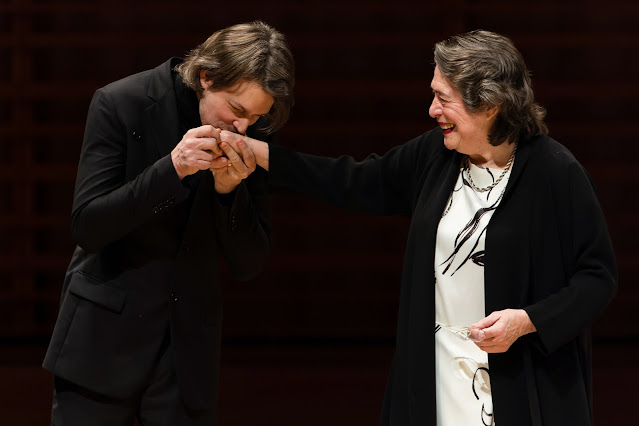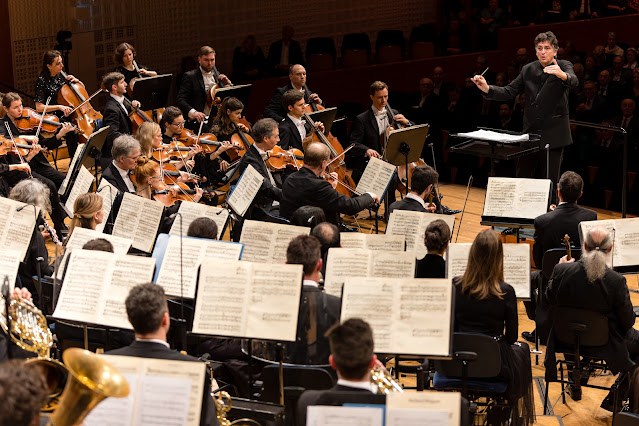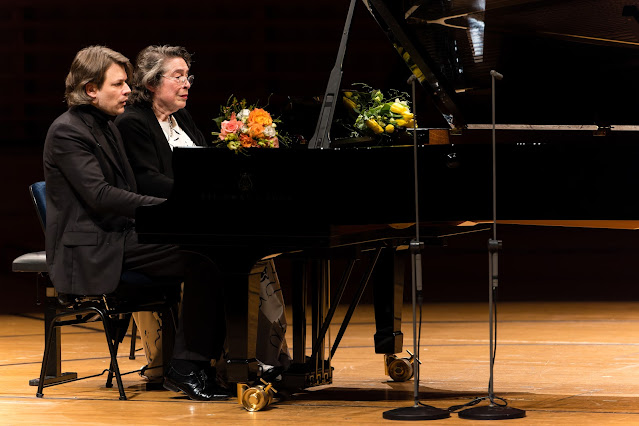 |
| Liszt: Piano Concerto No. 2 - Yoav Levanon, Lucerne Symphony Orchestra - Le Piano Symphonique, Lucerne (Photo: Philipp Schmidli) |
Liszt: Piano Concerto No. 2, Wagner, arr. Michael Sanderling: Götterdämmerung Suite, Schumann: Symphonic Etudes, Op 13, Schubert: Allegro in A minor, D947; Yoav Levanon, Lucerne Symphony Orchestra, Michael Sanderling, Elisabeth Leonskaja, David Fray; Le Piano Symphonique at KKL, Lucerne
Reviewed 18 January 2024
From Lisztian bombast to Wagnerian sorcery with the Lucerne orchestra in fine fettle, then the contrast of mesmerising solo Schumann from Elisabeth Leonskaja and ending with pure friendship as she and David Fray duetted
The history of Liszt's piano concertos is somewhat complex. He began sketching ideas for what would become his first piano concerto in 1830, but it did not come to completion until 1849. In the mean time, he began work on what would become his second piano concerto in 1839/40 but did not complete the final revisions to the work until 1861. By this time his career as a virtuoso was over, so the two concertos have rather different aims. The first is a virtuoso vehicle, allowing space for the soloist who initiates ideas. The second is closer to Liszt's symphonic poems with the piano having a more accompanying role. As such, it was fascinating to hear the two played on successive evenings by the same soloist, orchestra and conductor, in the same hall.
 |
| David Fray, Elisabeth Leonskaja - Le Piano Symphonique, Lucerne (Photo: Philipp Schmidli) |
On 18 January 2024, Le Piano Symphonique continued its Liszt cycle with Liszt's Piano Concerto No. 2 performed by Yoav Levanon with the Lucerne Symphony Orchestra conducted by Michael Sanderling [see my review for their performance of the first concerto]. The Liszt was followed by Michael Sanderling's orchestral suite from Wagner's Götterdämmerung. After the break, things became more intimate with pianist Elisabeth Leonskaja playing Schumann's Symphonic Etudes, Op 13 and she was joined by pianist David Fray for Schubert's Allegro in A minor, D947.
The concerto began with the large orchestra bringing a real chamber-music feel to the music. Yet for all Yoav Levanon's virtuosity, the piano's role felt secondary and when the march-like music really got going we were definitely in tone-poem territory with some terrific colours in the orchestra. When they fined down to nothing, Levanon brought elegance to the solo part, particularly when joined by the orchestra's solo cello. But throughout the music kept a sense of flow, whilst the orchestra contributed a chamber elegance. When the more dramatic material returned so did the feeling of a Liszt tone poem, but Levanon had no trouble producing really robust virtuosity, as well as contributing moments of poetry before the work's thundering conclusion.
It is interesting to consider the date of the concerto; it was premiered in 1861, three years after Brahms' Piano Concerto No. 1 was premiered. Brahms would take a more conventional approach to structure than Liszt, but he was able to develop the soloist's role in a way that was innovative rather then decorative.
 |
| Wagner: Götterdämmerung suite - Michael Sanderling, Lucerne Symphony Orchestra - Le Piano Symphonique, Lucerne (Photo: Philipp Schmidli) |
Over in Bavaria, the sorcerer of Bayreuth was working hard on the Ring Cycle. He began the music for Das Rheingold in 1853 (whilst still in exile in Switzerland), started work on Götterdämmerung in 1869 and finished it in 1874. Liszt helped Wagner financially at various points in his life (including the abortive return to Paris in 1861), and in the 1860s Liszt's daughter by Marie d'Agoult (with whom Liszt lived in Geneva in the 1830s), Cosima, began a relationship with Wagner. So there are both musical and personal links between the composers. But still, the transition from Liszt's tone poem-like music for the concerto and the mysterious opening of Götterdämmerung was striking.
Michael Sanderling's suite was in a long single movement lasting around 40 minutes, moving seamlessly, and Sanderling said in my recent interview with him that every note in the suite is Wagner's. We spent a long time in the Prologue and Act One then ended with the Funeral March, Immolation Scene and closing sequence.
There were plenty of incidental beauties and once over some initial hesitations and awkward tuning, the orchestra embraced the music and brought an architectonic flow to it, helped by Sanderlin's steady but never relentless speeds. The drawback of the suite was that unless you knew the opera well, you had no idea what was what; perhaps it needed surtitles. By the Funeral March we were on firmer ground and the orchestra was producing a vivid array of colours, then it was the Immolation Scene and here I really did miss the voice, Brünnhilde's cries echoed in my inner ear. The concluding orchestral sequence remains one of my favourite moments from the Ring as Wagner weaves the various themes together in a way which summarises what has happened but also creates a tone poem every bit as striking as those of his father-in-law. The suite was, frankly, rather too long but the orchestra acquitted itself magnificently, bringing its distinctive approach to Wagner.
After the pause we went from an over-full stage to just one piano, one pianist. Elisabeth Leonskaja began Schumann's Symphonic Etudes without ado. He began them in 1834 as a set of variations based on a theme sent to him by the guardian of Ernestine von Fricken, the Estrella from Carnaval and someone Schumann was briefly engaged to in 1834. Thus, as with much of his music, an autobiographical element enters the work made more complex by the fact that Schumann did not use all the variations in the published work, and added a final etude based on another theme! What we have is a series of character pieces; Symphonic Etudes was dedicated to Sterndale Bennett, who played it frequently in England, though Schumann would advise his wife Clara not to play it in public!
From the very outset, Leonskaja played with a subtle expressiveness, giving each etude its own distinctive atmosphere, yet doing so with what were often small gestures, just what was needed and not showy, even in the more bravura movements. Throughout the work she created remarkable changes of mood with very subtle means, and we were completely mesmerised for the 35 minutes of the piece.
 |
| Schubert: Allegro - David Fray, Elisabeth Leonskaja - Le Piano Symphonique, Lucerne (Photo: Philipp Schmidli) |
The evening ended on a wonderful note of joy as Leonskaja was joined at the piano by David Fray for Schubert' s Allegro in A minor 'Lebenssturme'. One of Schubert's late works for piano duet, the movement might have been intended as part of a two-movement sonata with the Rondo in A major, D951 but it was published in 1840 with the title Lebenssturme (chosen by the publisher). It is a single, large-scale sonata movement that we experience with a lovely subtle, rich texture created by the two pianists at one piano. They gave the music a sense of constant, subtle movement out of which themes and motifs emerging and retreating. The two performers had a lovely rapport, obviously in sympathy, clearly enjoying themselves and creating a remarkable sense of electricity. Their body language was similarly sympathetic, sometimes swaying together, sometimes bouncing in time for the rhythmic chords. Music for piano duet has a social element, and though this is one of Schubert's richest large-scale sonata-form movements, part of the fun came from the performers sense of enjoyment of its riches. And we were treated to an encore, a further dance from the same Schubert volume.
Never miss out on future posts by following us
The blog is free, but I'd be delighted if you were to show your appreciation by buying me a coffee.
Elsewhere on this blog
- An evening of bold & adventurous programming: wind & brass from Southbank Sinfonia & Britten Sinfonia combine - concert review
- Le Piano Symphonique in Lucerne: Made in Switzerland, tenor Daniel Behle & pianist Oliver Schnyder combine musicality & intelligence - concert review
- Le Piano Symphonique in Lucerne: From poetic Liszt and Grieg concertos to a little bit of magic from Martha Argerich and friends - concert review
- Eavesdropping on their dramas: Opera North's 'in the round' production Britten's Albert Herring - opera review
- A shelter where people can be sure of quality and find so much to discover: founder Michael Adda on his record label, La Dolce Volta - interview
- Byrd Compared: Phantasm & Anna Prohaska celebrate the consort song - concert review
- Slowly, through a process of osmosis, the piece and I are slowly becoming acquainted: horn player, Ben Goldscheider on Gavin Higgins' new Horn Concerto - guest posting
- At Kings Place this month, Turkish pianist Can Çakmur celebrates the Hamamatsu Competition which he won in 2018, not to mention embarking on his 12-disc Schubert with BIS - interview
- Sheer delight: William Christie & Les Arts Florissants celebrate New Year's Eve at Wigmore Hall in fine style - concert review
- A welcome relief from regular Christmas fare: the Tallis Scholars introduce us to the subtle riches of Jacobus Clemens non Papa - concert review
- Home



.jpg)







No comments:
Post a Comment